The walkers, cyclists and assorted day-tripping visitors of the Peak District should have no trouble hearing us coming.
It's an early July day in the middle of the working week (and, yes, this does count as work, although I never cease to be amazed about that), so I'm not too sorry to interrupt their peace.
I am, after all, only making the most of the opportunity while I can. Soon enough, the tourists will have nothing to detract from their leisure but electric motor whine and cattle flatulence (watch out, Daisy: you're next).
In front of us is a slightly mixed trio of cars that you might not have expected to appear together in the same group test. But since they've been chosen by fate and happenstance, not by me, they are what they are. Specifically, they are the last three front-engined, rear-wheel-drive, V8-powered sports cars left on sale in the UK.
From the late 1950s right the way through to the rise of the affordable mid-engined sports car in the 1990s, this was how it was done.
Plonk a powerful V8 engine longways in the front of your lightweight chassis, sending its drive to the axle at the back, and then work on the finer engineering details later.
It was a proven successful recipe that produced sports cars as different as the AC Cobra, Chevrolet Corvette, TVR Griffith, Porsche 928, Jaguar XK and Aston Martin Vantage V8, along with a great many more that you might loosely have described as affordable in their day.
Today's varied band, among them a sporty luxury GT, an ageing British sports car and a much-celebrated legend of American muscle, is what remains to represent one of the most popular mechanical layouts that the sports car market has ever known.
A Ford Mustang GT can still be snaffled up for less than £50,000. The Lexus LC500 has just been taken off sale in the UK, although if you're content with a base model, you might just secure one used for a whisker under £100,000.
And the Jaguar F-Type, also now retired, previously split the difference on price between the other two, and just about meets our qualification criteria in as much as the mid-range P450 version has only one driven axle.
So which of these three is the best tribute to a classic mechanical recipe? Which should you seize, if you're so inclined, and treasure for as long as the world will allow? And which will we miss the most?
Engines
A V8 engine in the front of a useable, affordable, powerful sports car just makes good sense when you think about it. Yes, they burn hydrocarbons - quite a lot of hydrocarbons, obviously, and must therefore be wiped from the face of the planet as quickly as possible, according to good old public opinion.
But if we're mature enough to acknowledge that such a problem actually concerns not what they are but what they burn - and that there are ways to make clean, sustainable fuel for them, just as you can generate sustainable energy for an EV (although not every EV runs on it) - we might just make room to observe what makes them great.
V8 engines are remarkably weight- and space-efficient sources of power. Short engine blocks and stiff crankshafts allow them to use under-bonnet space in a clever way, to rev quickly and to develop high outputs. Wide cylinder-bank angles allow them to sit low, in turn lowering centre of gravity, and making space for forced induction systems as necessary.
You can have moderately powerful ones, or very powerful ones, or just about anything in between. And whatever you have, if the engine is carried up front and not right behind your head, you should have plenty of space left for passengers, luggage and jerry cans full of home-made 102-octane fuel - all of which may matter to an owner sooner or later.
Less objectively, V8s not only work well but also sound good while doing it. And lordy, do they ever. If this were a shouting competition, and the winner honoured with a residency at the Royal Albert Hall, the Lexus would be the most deserving. You might not expect it to be, because you don't instinctively associate Toyota or Lexus with the manufacturing of great V8s; you think 'hybrid', I bet. I certainly do.
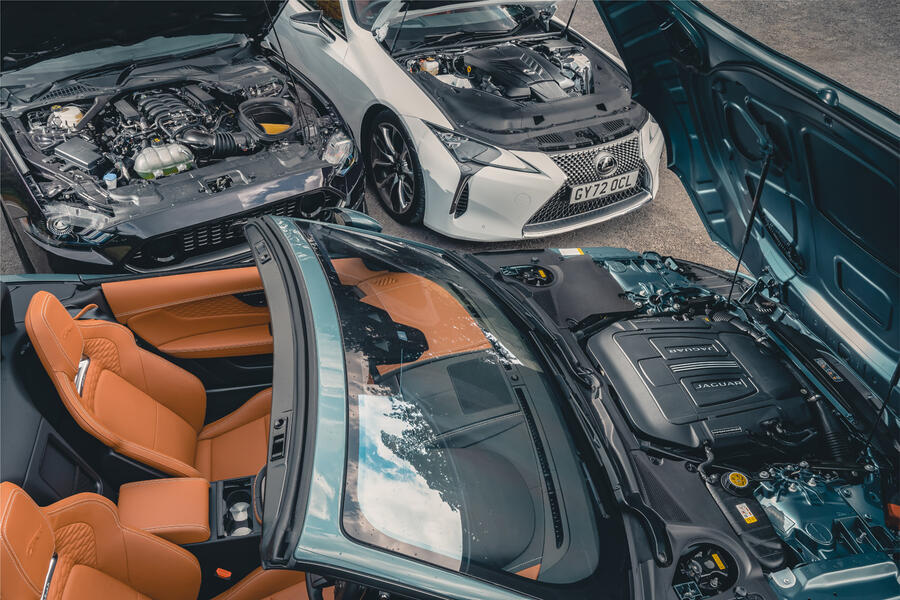
Well, think 'V8'. Because while the 'Coyote V8' in the Ford Mustang Mach 1 runs it very close thanks to its Shelby GT350 throttle bodies and induction system and its enlarged cylinder bores, the Lexus's '2UR-GSB' has it beaten for flamboyant noise.
Both engines are normally aspirated; so they both spend longer at revs, because they need them in order to make power (the Jaguar's supercharged V8 makes greater accessible torque). And that gives you plenty of time to drink in the various growls, gurgles and bellows they make - with tacho needles swinging to the far side of 5000rpm, and the world scowling in disbelief that you must have a vendetta against every remaining polar bear, bunny rabbit and endangered marine animal on the planet, you monster.
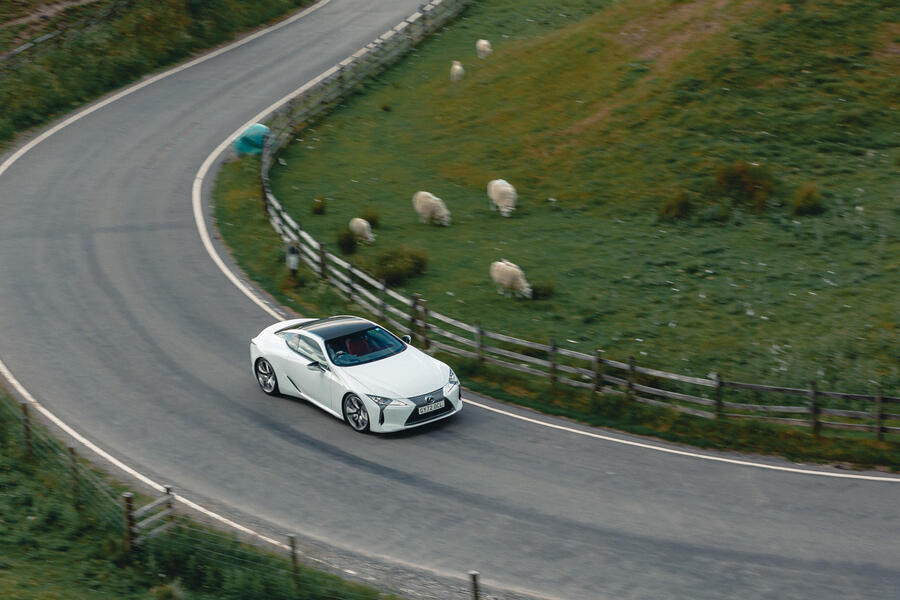
The scowls might just be worth it, though. The Lexus LC 500 has a genuinely musical engine. It's more hollow in its timbre than the decidedly more guttural and malevolent-sounding Ford, but it's so tuneful that it's almost piercing. In terms of outright potency, that oversquare cylinder design makes it feel a little under-endowed until you get about 4500rpm wound on - but the way the power delivery builds from there is utterly transformative.
You go from very luxurious but fairly ordinary-feeling motoring - the kind into which you need invest almost no physical effort at all, thanks to a 10-speed automatic gearbox, and surrounded as you are by remarkably expensive materials, and fully cosseted by Japanese 'omotenashi' opulence - to the totally extraordinary, hair-raising kind.
At 7000pm, it sounds almost operatic, a little like the extraterrestrial singer in sci-fi movie The Fifth Element. And once you've heard it, with your fingers on the paddle shifters that keep that motor spinning in its sonorous sweet spot, you won't want to go back.
The Mustang, by way of contrast, gives you nothing for nothing: its simplicity, honesty and directness are the heart and soul of its appeal. Its ride is grittily firm and brusque at low speed, its Tremec six-speed manual gearbox both short of throw and almost wilfully stubborn. Driving it in town makes you wish you had spent longer up in the hills.
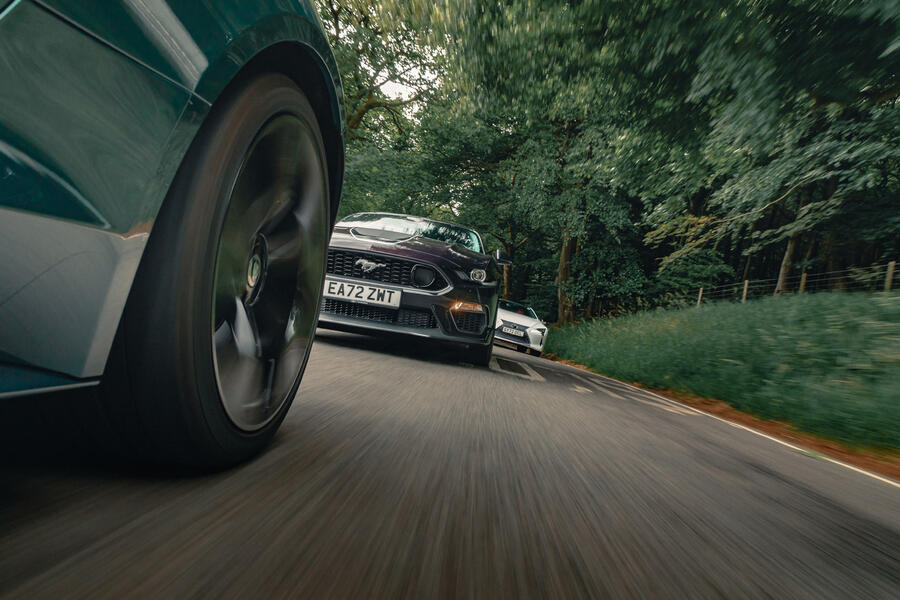
But that's alright. This is a muscle car, and one with some appealing historical roots at that. Put your foot down on the open road and that's genuine old-school induction hammer coming right at you through the air vents. It's an aggressive and antediluvian but totally authentic sort of noise, and it's wonderfully savage as it builds.
In terms of all-around audible interest value and all-around quality, the Mustang gives up nothing to the Lexus - and that it's damned near as powerful is quite remarkable when you think that it must have been engineered on a fraction of the Japanese engine's budget.
So where does our plucky, demob-happy, 75th-anniversary Brit slot in for combustive drama? The Jaguar F-Type P450 wins some points by being the most accessibly urgent car of the three. Let's not pretend, after all: if you're buying a V8 sports car, presumably you would like it to be quick? The Jaguar is certainly that.
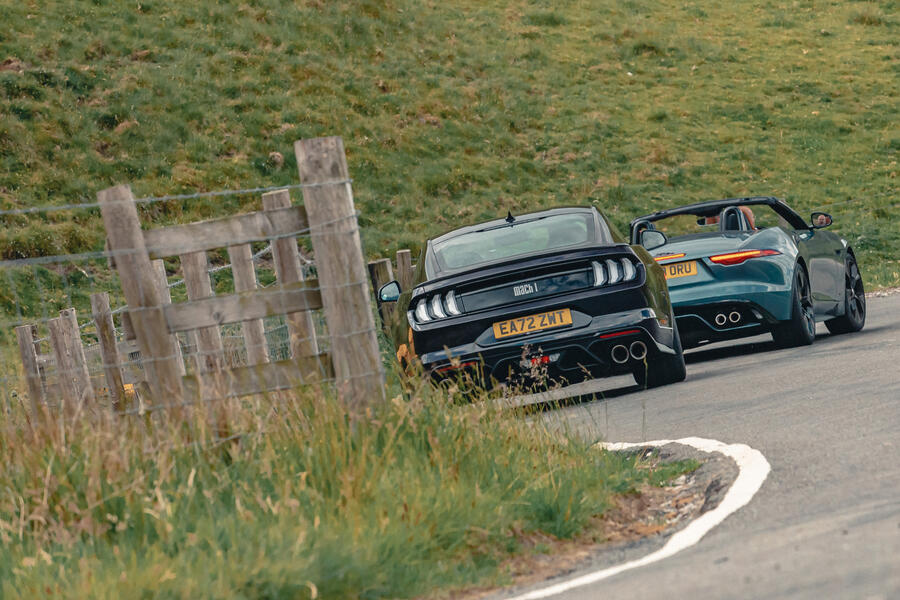
The supercharged torque of the 'AJ133' engine surges away using revs at which the Ford and Lexus feel like they're barely ticking over. Then it hurls you down the road in fully unapologetic fashion, while you would still be waiting for either of the other two to really begin hollering at the scenery.
The trade-off? The F-Type doesn't really rev like its rivals, its ferocity perceptibly in decline past 5000pm; and it sounds considerably less crisp and mechanically interesting than either the Lexus or the Ford.
This is an engine with a relatively heavy iron crankshaft and forced induction, but it doesn't really add any of the audible interest of old Jaguar performance V8s with their spin-cycle supercharger whine.
You probably wouldn't find as much fault with it in isolation, but next to the other V8s, it feels a bit of a brutish Machiavelli. Keep it hauling through that torquey mid-range using slightly early upshifts and your ears will remain fully pinned back. But that is by far the F-Type's most convincing trick.
How do they drive?
Sports cars are more than just great engines in nice-looking presentation boxes. So is this where the Lexus's softer luxury-GT edges and the Ford's muscle-car dynamic crudity catch up with them and the Jaguar's fightback begins?
Nope. I will admit that I expected something like that. But while the Mustang is indeed a larger-feeling car than either the LC or the F-Type, it's one that gets better the harder you're prepared to drive it.
But the LC, too, has a surprising willingness to stay level, cut loose and shrug off its near two tonnes of kerb weight when you select the right driving mode. It's a master of real-time transformation, swivelling and entertaining like a much lighter car.
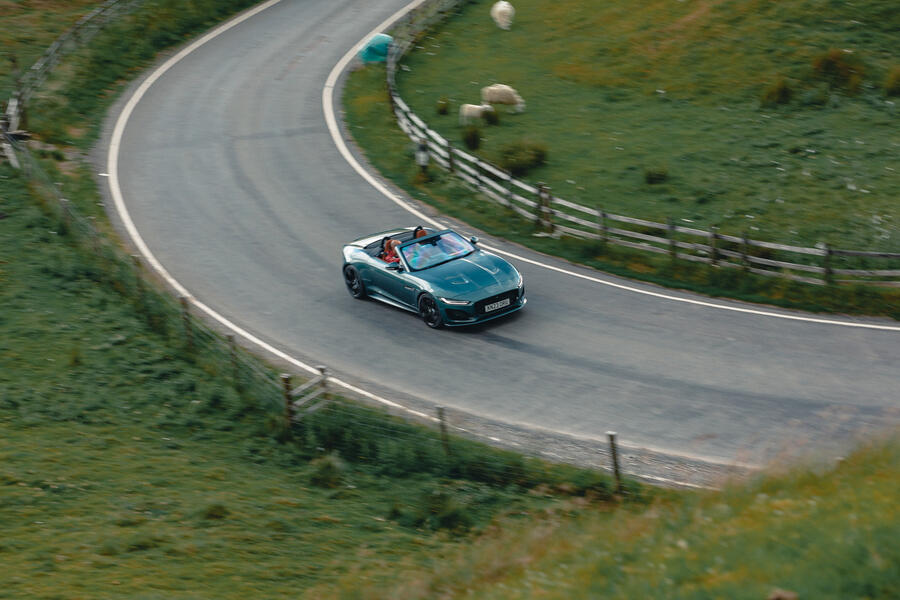
There is more than a suggestion of brittleness, however, to the general deportment of the Jaguar F-Type 75 P450 Convertible, and a bustling firmness to its ride that you don't see coming. Sports cars, over their lite cycles, sometimes tend to go in this direction - often because it's the only way open to them.
Wheel sizes swell, lateral and vertical stiffness is hiked, axles are located ever more firmly, all in an attempt to give customers a different experience and a reason to come back. It's happened to Lotuses, TVRs, Nissan Zs and BMW Ms, and still does.
Now it seems to have happened to the F-Type. This car used to have a natural affinity for pockmarked, undulating British country roads, but now, in its dotage, it seems to have become just a little bit lead-footed and stiff at the knees.
The Lexus has a similar problem - but, at least with this car, you can diagnose it very quickly, and could potentially cure it quite simply. In transferring from show car to showroom reality some time in the late Noughties, the LC's designers decided they didn't want to make room for a spare wheel within its svelte silhouette - not even a skinny space-saver.
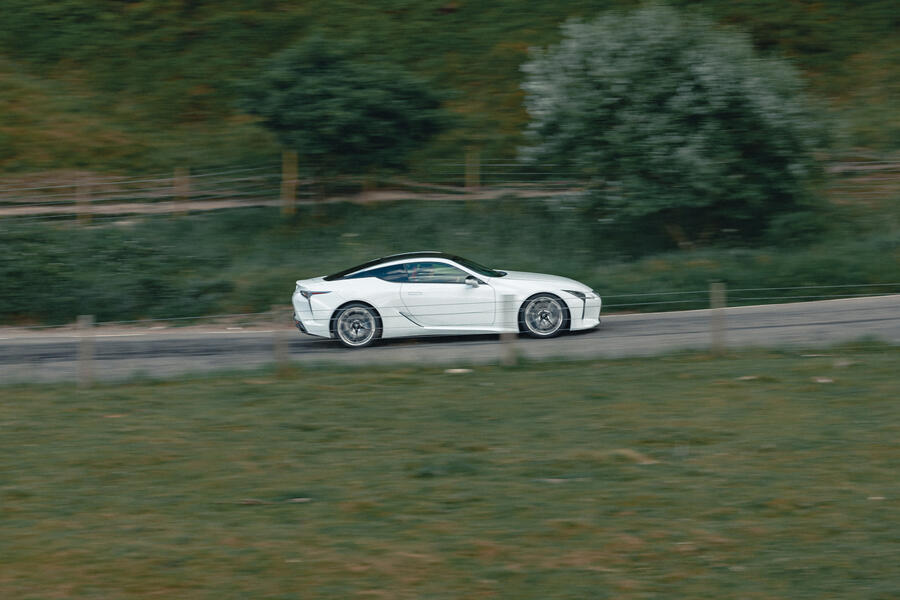
So they issued an edict that it should have run-flat tyres instead. Oh dear. Those tyres, adorning a set of 21in wheels that look very pretty, if heavy - would be among the first things I'd change about any LC that I owned. With softer tyre sidewalls, I'd bet this would be a really enticing drive.
Even as it is, the Lexus has better vertical body control than the Jaguar, with just enough suppleness about it. Four-wheel steering and a Torsen limited-slip differential help it into, through and out of corners instinctively and with just a little handling adjustability if you're inclined to go looking for it.
You have to wrestle the Mustang that bit more to get the best out of it, keeping tabs on its size, and rowing that heavy manual gearchange around the gate between corners. But the car's grasping damping and meaty control weights make sense at speed, when you're putting the effort in - and it's an effort that's rewarded.
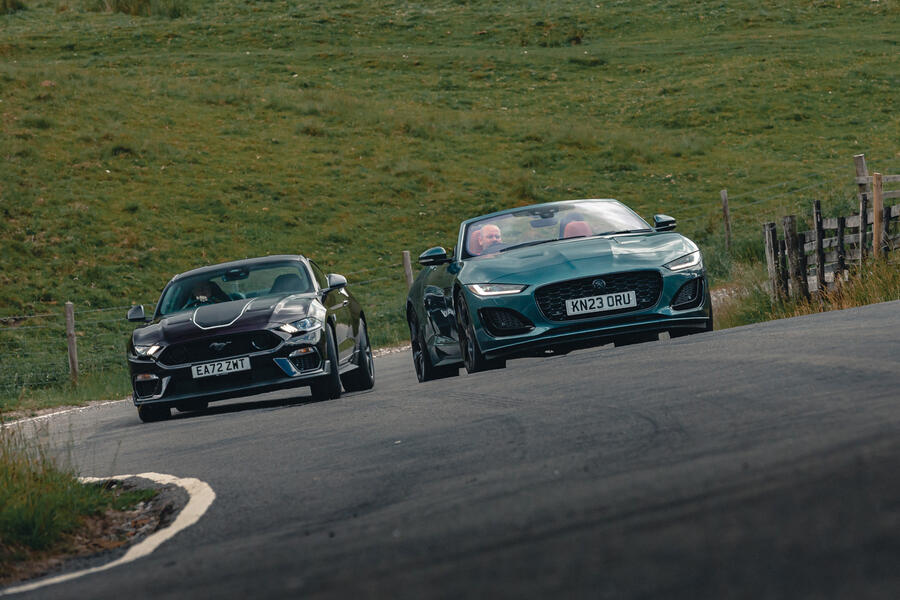
The Mustang never feels fleet of foot or remotely sophisticated, but it's more satisfying to drive than the F-Type and brimming with charm.
Verdict
Which is why I'm happy enough that, of our trio, the Mustang Mach 1 is the V8 sports car that the petrolhead would choose to save for posterity, whether they knew or even cared very much about what it was like to drive.
The fact is, the Mustang is a lot of fun to drive. But it attracts all the attention; it simmers with all the presence and visual aggression; it is the automotive icon among lesser-known curios in the Jaguar and Lexus.
I'd save the old Mustang, too, if I'm honest - although, ironically enough, as long as North America keeps buying them, it's probably the car least in need of urgent preservation.
It's not quite the car I'd most enjoy driving, though, or get most use out of, or drink from most deeply when I did. For those things, I'd be looking at the unexpectedly naughty, strangely intoxicating and enticingly imperfect LC.

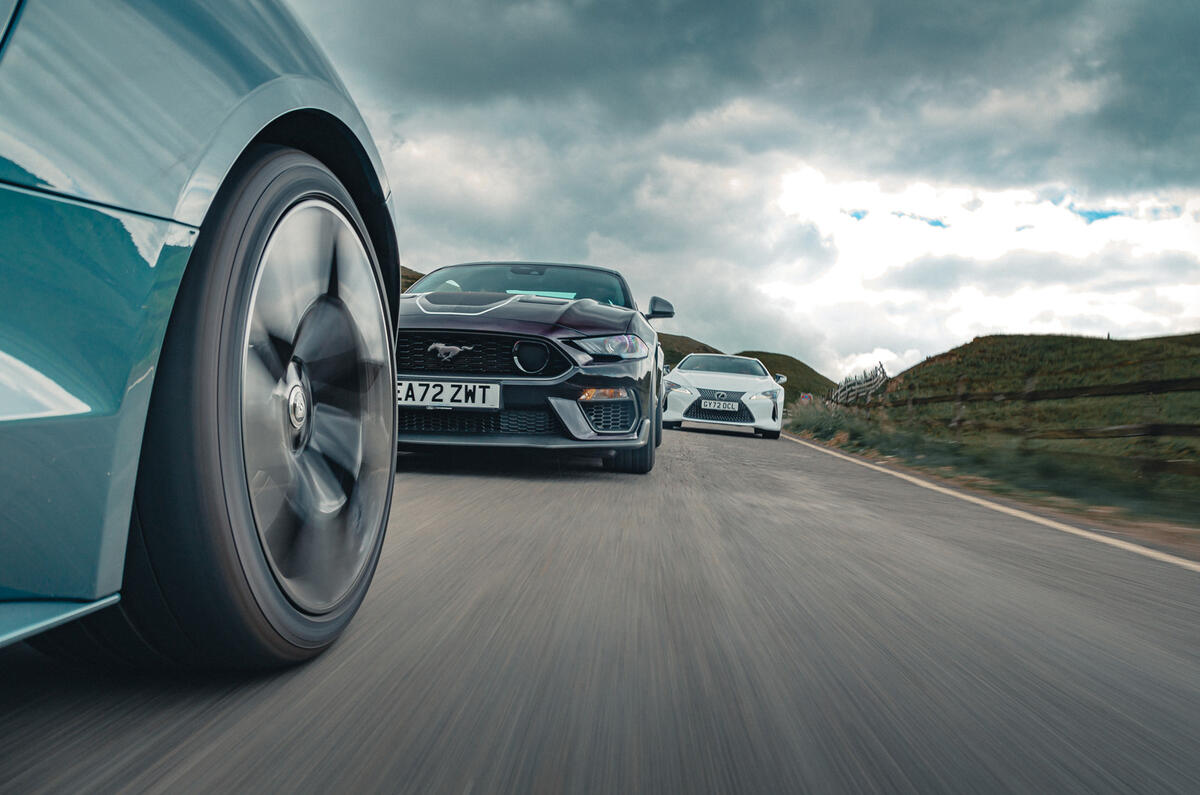






Join the debate
Add your comment
Not quite following the logic of the final verdict! So the lexus is 'intoxicating to drive' but it is 'not as dynamically capable as rivals'?
Either the Lexus can't be that intoxicating to drive, or the rivals must be more special to drive, surely!
£100K Toyota? No thanks....
Adding high-end luxury to the best engineered cars in the world was never going to be cheap.